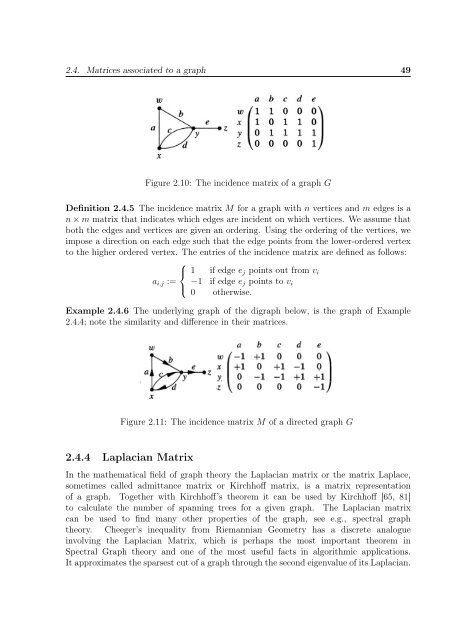enumeration of the number of spanning trees in some ... - Toubkal
enumeration of the number of spanning trees in some ... - Toubkal
enumeration of the number of spanning trees in some ... - Toubkal
Create successful ePaper yourself
Turn your PDF publications into a flip-book with our unique Google optimized e-Paper software.
2.4. Matrices associated to a graph 49Figure 2.10: The <strong>in</strong>cidence matrix <strong>of</strong> a graph GDef<strong>in</strong>ition 2.4.5 The <strong>in</strong>cidence matrix M for a graph with n vertices and m edges is an × m matrix that <strong>in</strong>dicates which edges are <strong>in</strong>cident on which vertices. We assume thatboth <strong>the</strong> edges and vertices are given an order<strong>in</strong>g. Us<strong>in</strong>g <strong>the</strong> order<strong>in</strong>g <strong>of</strong> <strong>the</strong> vertices, weimpose a direction on each edge such that <strong>the</strong> edge po<strong>in</strong>ts from <strong>the</strong> lower-ordered vertexto <strong>the</strong> higher ordered vertex. The entries <strong>of</strong> <strong>the</strong> <strong>in</strong>cidence matrix are def<strong>in</strong>ed as follows:⎧⎨ 1 if edge e j po<strong>in</strong>ts out from v ia i,j := −1 if edge e j po<strong>in</strong>ts to v i⎩0 o<strong>the</strong>rwise.Example 2.4.6 The underly<strong>in</strong>g graph <strong>of</strong> <strong>the</strong> digraph below, is <strong>the</strong> graph <strong>of</strong> Example2.4.4; note <strong>the</strong> similarity and difference <strong>in</strong> <strong>the</strong>ir matrices.Figure 2.11: The <strong>in</strong>cidence matrix M <strong>of</strong> a directed graph G2.4.4 Laplacian MatrixIn <strong>the</strong> ma<strong>the</strong>matical field <strong>of</strong> graph <strong>the</strong>ory <strong>the</strong> Laplacian matrix or <strong>the</strong> matrix Laplace,<strong>some</strong>times called admittance matrix or Kirchh<strong>of</strong>f matrix, is a matrix representation<strong>of</strong> a graph. Toge<strong>the</strong>r with Kirchh<strong>of</strong>f’s <strong>the</strong>orem it can be used by Kirchh<strong>of</strong>f [65, 81]to calculate <strong>the</strong> <strong>number</strong> <strong>of</strong> <strong>spann<strong>in</strong>g</strong> <strong>trees</strong> for a given graph. The Laplacian matrixcan be used to f<strong>in</strong>d many o<strong>the</strong>r properties <strong>of</strong> <strong>the</strong> graph, see e.g., spectral graph<strong>the</strong>ory. Cheeger’s <strong>in</strong>equality from Riemannian Geometry has a discrete analogue<strong>in</strong>volv<strong>in</strong>g <strong>the</strong> Laplacian Matrix, which is perhaps <strong>the</strong> most important <strong>the</strong>orem <strong>in</strong>Spectral Graph <strong>the</strong>ory and one <strong>of</strong> <strong>the</strong> most useful facts <strong>in</strong> algorithmic applications.It approximates <strong>the</strong> sparsest cut <strong>of</strong> a graph through <strong>the</strong> second eigenvalue <strong>of</strong> its Laplacian.

















